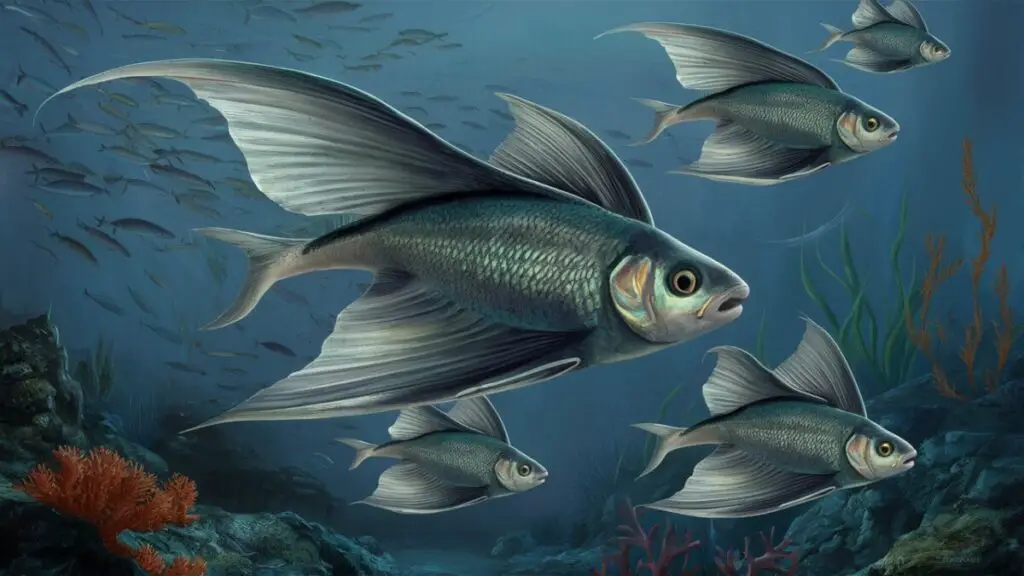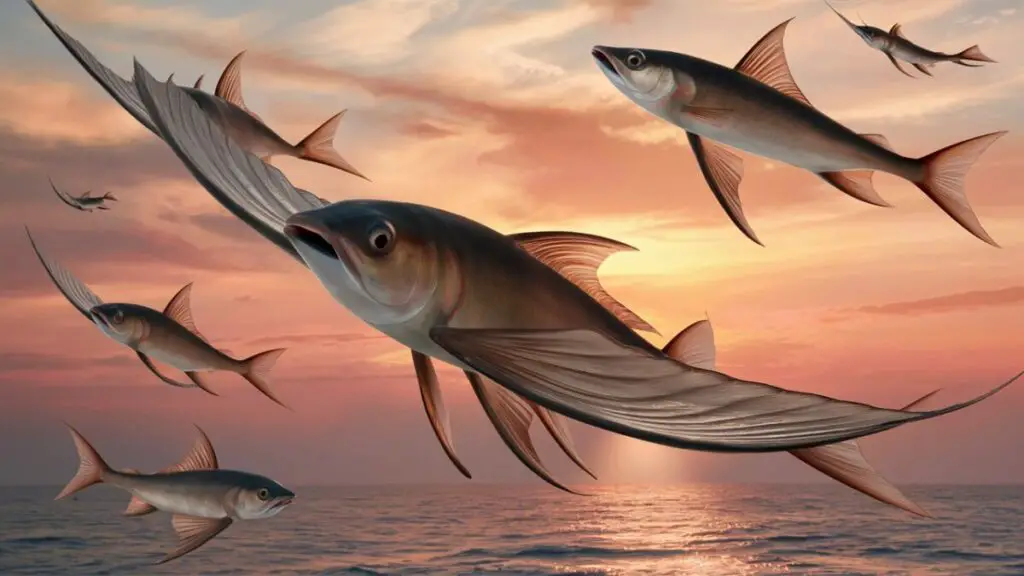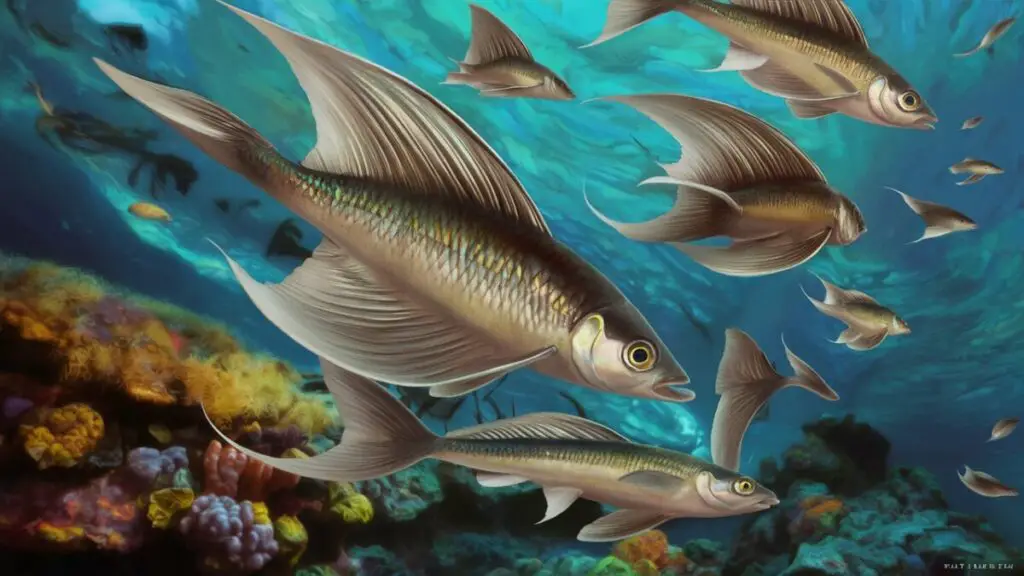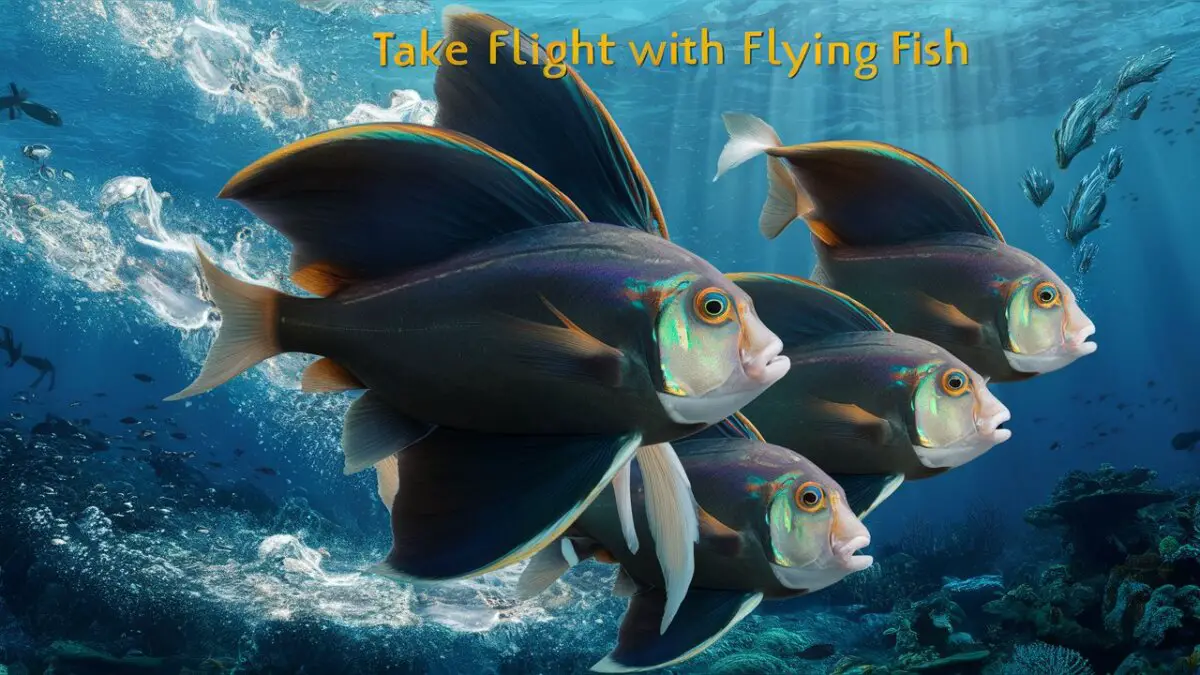Take Off with Flying Fish: An in-depth exploration of their remarkable capabilities Take a thrilling dive into the fascinating world of flying fish and enjoy an amazing adventure through its depths.
These amazing animals challenge our preconceived notions about marine life and exhibit a special adaptation that enables them to soar above the surface of the ocean.
In this engrossing investigation, discover the mysteries underlying their remarkable skills as we look at the evolutionary wonders that allow them to soar through the air with elegance.
Flying fish are more than just graceful underwater fish; they have developed to rule the air, uniting two apparently unrelated domains.
Join us as we explore the anatomical and physiological characteristics that enable this phenomenon and uncover the science behind their flying skill.
Every detail contributes to the mystery surrounding these aquatic aviators, from the intricate patterns on their wing-like fins to the calculated movements they use to achieve a successful flight.
As we explore the mysteries of these winged creatures’ flying adventures, get ready to be fascinated by their tales.
“Take Flight with Flying Fish” invites you to experience nature’s inventiveness in producing animals that transcend the barriers between water and sky. It promises to be a deep dive into these aquatic marvels’ amazing world.
Key Points
- Soaring Wonders: Unveiling the Secrets of Flying Fish Flight
- Aquatic Aviators: How Flying Fish Navigate Two Worlds with Grace
- Winged Marvels of the Sea: The Physics Behind Flying Fish Propulsion
- Beyond the Surface: Exploring the Evolutionary Wonders of Flying Fish
- Airborne Acrobats: The Remarkable Adaptations that Allow Fish to Fly
- Aerial Mastery: How Flying Fish Inspire Biomimicry and Technological Innovation
- Conclusion
You may also like this: Flying Fish: Masters of Aerial Escape in the Deep Blue

Soaring Wonders: Revealing the Mysteries of Fish Flight on Air
Have you ever been in awe of the elegant way that flying fish glide over the surface of the water?
These aquatic marvels have developed a special capacity that enables them to fly and escape the limitations of the water, providing an amazing demonstration of natural aerodynamics.
The remarkable pectoral fins of the flying fish, which have developed into strong, wing-like structures, are the key to its aerial abilities.
The fish may now attain controlled flight thanks to these fins, which are more than simply tools for moving through the water.
A flying fish rushes underwater, breaches the surface at an angle, and spreads its pectoral fins to produce improvised wings in order to detect a predator or simply go faster.
The fish can fly a considerable distance—up to several hundred feet—once they are in the air. They appear to transcend the lines separating the water from the sky, making it a wonder to behold.
The physics of flying fish have fascinated researchers, who have studied their motions to learn more about aerodynamics.
Drone and aircraft design advances have drawn inspiration from the way these creatures maneuver through the air.
Thus, keep a lookout for these flying beauties the next time you find yourself near the beach.
By pushing the limits of what we previously believed to be feasible in the fluid physics of flight, the flying fish’s ability to transcend the watery world serves as a reminder of the wonders that nature has to offer.

Using Grace, Flying Fish Handle Two Worlds in Aquatic Aviators
A fascinating species that has perfected the ability to move between two realms with unmatched precision lives in the enormous expanse of the world’s oceans: the flying fish.
With their sleek bodies and specially designed fins, these aquatic aviators escape the constraints of underwater life to soar above the skies in a breathtaking exhibition of nature.
Fish that can fly have developed adapted pectoral fins that function as wings, allowing them to hover above the water.
These amazing adaptations allow them to travel long distances, avoid predators, and even capture prey.
Their wing-like fins unfurl as they push themselves out of the water, using the wind’s force to drive them over the waves.
It’s an amazing sight, proof of the complex dance between physics and biology.
The flying fish’s ability to navigate two very different habitats with such accuracy just serves to highlight how amazing their airborne skills are.
Millions of years of evolution have shaped them into real ambassadors of the oceans, commanding both air and water.
Their ability to use both skills is essential to their survival because it lets them avoid hiding predators and reach fresh feeding sites.
The amazing sight of flying fish skimming the water’s surface reminds us of the astounding diversity of life on our planet.
These aquatic aviators are a representation of adaptability, tenacity, and the limitless opportunities that result from the harmonious coexistence of evolution and environment.
You may also like this:From Sea to Air: The Marvelous Adaptations of Flying Fish

Sea’s Winged Wonders: The Science of Flying Fish Propulsion
The vastness of the ocean hosts a spectacular show of winged marvels soaring above the waves takes place in the vastness of the ocean.
No, these aren’t birds; instead, they are amazing flying fish that gracefully glide through the skies, disobeying the limitations of aquatic existence as we know it.
Their special propulsion’s mechanics are a tribute to nature’s miracles.
Fish of the Exocoetidae family are known to fly, and their aerial antics are more than just a comical show.
Rather, they have developed this amazing skill as a means of survival.
When predators pursue them, these fish use their pectoral fins, which have evolved into wing-like structures, to propel themselves out of the water and into the air.
The way the propulsion system works is like a physics concerto.
The fish accelerate underneath, and as they break the surface, they expand their pectoral fins, which provide them the lift they need to take off.
For this process to occur, the concepts of aerodynamics and hydrodynamics must cooperate.
The key is the way their tails beat quickly against the water, giving them a sudden burst of speed and a lifting force that helps them take off.
Once in the air, the flying fish can travel enormous distances, dodging predators and taking spectators by surprise with their elegant aerial ballet.
Knowing the physics of flying fish propulsion not only increases our admiration for the wonders of the sea, but also sheds light on how creatively nature has responded to adversity.
Even at the bottom of the ocean, the laws of physics shape life in remarkable ways, as these amazing creatures with wings serve as a reminder.

Beyond the Surface: Investigating the Wonders of Flying Fish Evolution
These amazing animals, which are members of the Exocoetidae family, have developed special characteristics that let them temporarily elude the water and soar into the air.
The evolution of flying fish is one example of an amazing feat of adaptability and survival.
These nimble fish have evolved unique pectoral fins over millions of years, which function as wings and allow them to glide astonishingly long distances.
This evolutionary invention helps animals avoid predators that hide under the surface and go farther in search of food or suitable mating sites.
In addition to their physical modifications, flying fish exhibit amazing behavioral patterns.
They frequently band together in schools, using their collective wisdom to make better use of the sky and avoid soaring predators.
It’s amazing to see these schools in action as proof of the value of cooperation in the natural world.
Beyond their fascinating aerobatics, flying fish have ecological value.
They are an essential component of the marine food chain, acting as a bridge between larger predatory species and the plankton-rich surface waters as they move over the ocean’s surface.
Take Flight with Flying Fish
Their role in energy transmission and nitrogen cycling emphasizes how intertwined marine ecosystems are.
To summarize, the evolutionary mysteries of flying fish entice us to learn more about the complexities of life below the surface of the ocean.
Not only is it amazing to see them cross the boundaries of air and sea, but it also teaches us about adaptability, teamwork, and the never-ending dance of survival in the dynamic fabric of the natural world.
You may also like this: A Journey into the Extraordinary Lives of Aquatic Creatures

Fish are able to fly because to the remarkable adaptations of airborne acrobats.
Although fish are renowned for their elegance and dexterity in the water, certain species have truly surpassed all others in their aquatic prowess.
A small number of fish have developed the remarkable ability to fly, allowing them to travel through the air with startling accuracy.
It isn’t magic that causes this occurrence; rather, it’s the incredible adaptations that these aerial performers have evolved.
Fish’s streamlined body design is one of the main characteristics that allow them to soar through the skies.
For example, flying fish can glide smoothly over the water’s surface because of their sleek, torpedo-like design, which reduces air resistance.
Furthermore, their pectoral fins have developed into substantial, wing-like appendages that, when extended, function as temporary wings.
These fins give the fish the lift they need to escape the water’s confines and soar through the air.
Flying fish, on the other hand, use a special swimming method in addition to their shape to generate the momentum required for takeoff.
These aerial specialists unleash a burst of speed, launching themselves into the air by swiftly flapping their tails.
Their pectoral fins function as wings once they are in the air, enabling them to regulate their trajectory and even change course mid-air.
Fish’s development of flight serves as an example of how incredibly adaptable life is under water.
These aerial performers transform the common activity of swimming into a breathtaking exhibition of aerial skill, serving as a constant reminder of the limitless inventiveness of nature.
The next time you look out over the ocean, imagine the hidden world beneath the waves, where fish have learned to fly in a captivating dance in addition to being skilled swimmers.

Aerial Mastery: How Technological Innovation and Biomimicry Are Inspired by Flying Fish
The remarkable ability of the flying fish to glide above the water’s surface has captivated scientists and engineers alike.
This natural wonder has spurred technical innovation in the quest for effective and sustainable aerial travel through biomimicry.
The flying fish’s ability to navigate the air-water interface has piqued interest in creating technological tools that mimic its elegant flight.
The fish’s wing-like pectoral fins, which enable it to switch between swimming and aerial glide with ease, are the subject of research for engineers.
By comprehending the complex workings of this underwater aviator, scientists want to develop drones and airplanes that can use similar concepts.
The technique known as “biomimicry,” which uses ideas from nature to address problems facing humans, is a potent source of creativity.
The flying fish’s ability to fly has applications beyond aviation. It can move through both water and air.
Researchers are investigating underwater robotics applications, developing vehicles that can fly over the air and explore the depths of the ocean with ease.
As are opening up new avenues for sustainable travel and exploration as we learn more about the flying fish.
Adopting the concepts of biomimicry can help us get closer to a day when technology reflects the efficiency and grace of the natural world.
The flying fish encourages us to strive for ever-higher levels of technical proficiency by serving as a witness to nature’s wonders.
You may also like this: Explore the Thrills of the Most Dangerous Aquarium

Conclusion
In summary, learning more about the amazing domain of flying fish shows a realm of remarkable skills that transcend the traditional limits of marine life.
These aquatic marvels never cease to amaze us, whether it’s with their amazing flying antics or unusual physiological adaptations.
Flying fish challenge our conception of the possibilities for evolution, reminding us of the wonders that lurk beneath the ocean’s surface.
Beyond their breathtaking beauty and elegant soaring, flying fish are living examples of the flexibility and resiliency needed to survive in the wide open sea.
Seeing them float above the waves is amazing and shows how well nature has adapted to the waterier environment.
Thus, let’s explore the depths of their universe and gain an appreciation for the complex systems that allow flying fish to fly over the ocean.
By doing this, we are able to appreciate marine life’s beauty and the various ways that evolution has shaped these organisms into amazing flying creatures on a deeper level.
Take to the skies with flying fish, and let their remarkable talents rekindle your wonder at the astounding diversity that lives in the waters around our planet.
Hooked on Tech: Exploring the latest Fishing Gadgets that Anglers swear by.
In the realm of angling, where tradition and technology often converge, a new wave of fishing gadgets has emerged, transforming the way anglers approach their craft.
From advanced fish finders to smart bait systems, these innovations have not only revolutionized the fishing experience but have also garnered a loyal following among anglers worldwide.
Ghosthorn 11″ Aluminum Alloy Fish Lip Gripper with Scale – 40lbs Saltwater Fishing Grabber Tool, 360° Swivel Non-Slip Handle, Corrosion-Resistant Fish Holder for Caught Fish, Fish Control Tackle
$21.59 (as of July 11, 2025 06:19 GMT +00:00 – More infoProduct prices and availability are accurate as of the date/time indicated and are subject to change. Any price and availability information displayed on [relevant Amazon Site(s), as applicable] at the time of purchase will apply to the purchase of this product.)Drasry Saltwater American Fishing Cast Net 3/8inch Mesh Size for Bait Shrimp Trap Fish Heavy Duty Sinkers Throw Net 3FT/4FT/5FT/6FT/7FT/8FT/9FT/10FT Radius
$21.59 (as of July 10, 2025 19:41 GMT +00:00 – More infoProduct prices and availability are accurate as of the date/time indicated and are subject to change. Any price and availability information displayed on [relevant Amazon Site(s), as applicable] at the time of purchase will apply to the purchase of this product.)PLUSINNO Fishing Net Fish Landing Net, Foldable Collapsible Telescopic Pole Handle, Durable Nylon Material Mesh, Safe Fish Catching or Releasing
$16.12 (as of July 10, 2025 19:41 GMT +00:00 – More infoProduct prices and availability are accurate as of the date/time indicated and are subject to change. Any price and availability information displayed on [relevant Amazon Site(s), as applicable] at the time of purchase will apply to the purchase of this product.)Piscifun Fishing Pliers, Saltwater Fishing Pliers with Split Ring, Fish Hook Remover, Corrosion Resistance Fly Fishing Pliers with Braid Cutters, Sheath and Lanyard, Fishing Gear Gifts for Men
$18.99 (as of July 11, 2025 03:01 GMT +00:00 – More infoProduct prices and availability are accurate as of the date/time indicated and are subject to change. Any price and availability information displayed on [relevant Amazon Site(s), as applicable] at the time of purchase will apply to the purchase of this product.)Saltwater Fishing Pliers, Split Ring Pliers with Safety Lock, with Sheath and Lanyard Green
Now retrieving the price.
(as of July 11, 2025 06:19 GMT +00:00 – More infoProduct prices and availability are accurate as of the date/time indicated and are subject to change. Any price and availability information displayed on [relevant Amazon Site(s), as applicable] at the time of purchase will apply to the purchase of this product.)

























